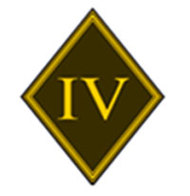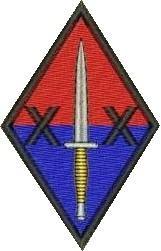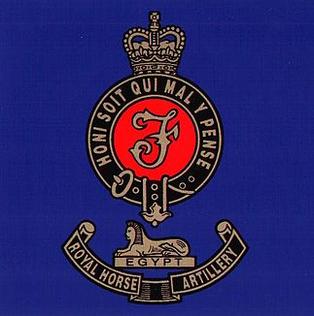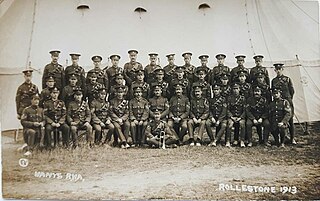
The Royal Regiment of Artillery, commonly referred to as the Royal Artillery (RA) and colloquially known as "The Gunners", is one of two regiments that make up the artillery arm of the British Army. The Royal Regiment of Artillery comprises thirteen Regular Army regiments, the King's Troop Royal Horse Artillery and five Army Reserve regiments.

The Royal Horse Artillery (RHA) was formed in 1793 as a distinct arm of the Royal Regiment of Artillery to provide horse artillery support to the cavalry units of the British Army. Although the cavalry link remained part of its defining character, as early as the Battle of Waterloo the RHA was sometimes deployed more along the lines of conventional field artillery, fighting from comparatively fixed positions.

105th Regiment Royal Artillery is part of the Army Reserve and has sub-units throughout Scotland and Northern Ireland. It is currently equipped with the L118 Light Gun.
The Battle of Sanna's Post was an engagement fought during the Second Boer War (1899–1902) between the British Empire and the Boers of the two independent republics of the Orange Free State and the South African Republic.

The Bermuda Militia Artillery was a unit of part-time soldiers organised in 1895 as a reserve for the Royal Garrison Artillery detachment of the Regular Army garrison in the Imperial fortress colony of Bermuda. Militia Artillery units of the United Kingdom and Colonies were intended to man coastal batteries in times of war, which were manned by under-strength numbers of regular army gunners in peace time. The unit was embodied during both world wars, fulfilling its role within the garrison, and also sending contingents overseas to more active theatres of the wars.

The 4th Regiment Royal Artillery is a regiment of the Royal Artillery in the British Army. It was formed in 1939 as 4th Regiment Royal Horse Artillery, before being redesignated in 1961.
3rd Regiment Royal Horse Artillery is a regiment of the Royal Horse Artillery in the British Army. They are currently based at Albemarle Barracks, Northumberland, England.
A Battery Royal Horse Artillery is the senior Battery in the British Army's Royal Artillery and is part of 1st Regiment Royal Horse Artillery. The Chestnut Troop is currently based in Purvis Lines at Larkhill Barracks. The unit is currently equipped as a Close Support Artillery Battery, with the AS-90 Self-propelled gun.
E Battery Royal Horse Artillery is a Close Support Battery of 1st Regiment Royal Horse Artillery. It is currently based in Purvis Lines in Larkhill Camp.
N Parachute Battery Royal Horse Artillery is a Tactical Group Battery of 7th Parachute Regiment Royal Horse Artillery. They are currently based in Merville Barracks Colchester, home of 16 Air Assault Brigade Combat Team.

20 Battery Royal Artillery is the headquarters battery of the 16th Regiment Royal Artillery. It is one of the five batteries that make up 16 Regiment Royal Artillery. The Regiment use the Rapier Field Standard C air defence missile system and the Land Environment Air Picture Provision (LEAPP) capability, the only Regiment in the British Armed Forces to do so.

F (Sphinx) Parachute Battery Royal Horse Artillery is a close support battery of 7th Parachute Regiment Royal Horse Artillery, part of the Royal Horse Artillery of the British Army, currently based in Merville Barracks in Colchester.

The Hampshire Royal Horse Artillery was a Territorial Force Royal Horse Artillery battery that was formed in Hampshire in 1909. It saw active service during the First World War in Egypt and Palestine from 1916 to 1918, initially as field artillery with 52nd (Lowland) Division before being converted back to horse artillery and serving with the Yeomanry Mounted Division and 1st Mounted / 4th Cavalry Division. A second line battery, 2/1st Hampshire RHA, served on the Western Front in 1917 and 1918 as part of an Army Field Artillery Brigade. Post-war, it was reconstituted as a Royal Field Artillery battery.
The Essex Royal Horse Artillery was a Territorial Force Royal Horse Artillery battery that was formed in Essex in 1908. It saw active service during the First World War in Egypt and Palestine from 1916 to 1918, initially as field artillery with 52nd (Lowland) Division before being converted back to horse artillery and serving with the 2nd Mounted / 5th Cavalry Division. A second line battery, 2/1st Essex RHA, served on the Western Front in 1917 and 1918 as part of an Army Field Artillery Brigade.
H Battery Royal Horse Artillery is a battery of 1st Regiment Royal Horse Artillery, part of the Royal Horse Artillery of the British Army. As of 2015, it is based at Albemarle Barracks, Northumberland, England and is equipped with GMLRS.

The page contains the current structure of the British Army. The British Army is currently being reorganised to the Future Soldier structure.

97 Battery Royal Artillery was formed on 13 September 1803 as Captain H. Douglas's Company, 8th Battalion Royal Artillery and is currently a tac battery within 4th Regiment Royal Artillery based in Alanbrooke Barracks, Topcliffe, North Yorkshire. The battery was until recently a gun battery but was reduced to a tactical or tac battery in 2013 following its last operational tour of Afghanistan. It is now one of three tac batteries that call in artillery fire from 4th Regiment Royal Artillery's two remaining gun batteries. The battery has been known by a variety of names during its existence and moved between different Royal Artillery Regiments or Battalions due to reorganisations of the Royal Regiment of Artillery and changes in role. In the First World War it fought as 87th (Howitzer) Battery, Royal Field Artillery.
The Antrim Artillery was a part-time reserve unit of Britain's Royal Artillery based in County Antrim, Northern Ireland, from 1853 to 1919. It numbered 1st on the order of precedence of the Militia Artillery. Volunteers from the unit served in the Second Boer War. During World War I it defended Belfast Lough and trained gunners for service overseas. Subsequent units continued the Antrim Artillery traditions.
The Mid-Ulster Artillery Militia was a part-time reserve unit of Britain's Royal Artillery based in Northern Ireland. Formed from three smaller units in 1875, it served until 1909.

The North Irish Division, Royal Artillery, was an administrative grouping of garrison units of the Royal Artillery and Artillery Militia in Ireland from 1882 to 1889.









